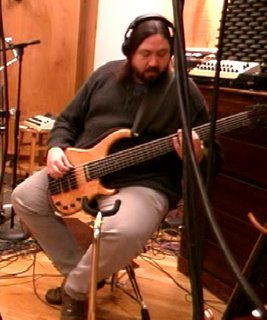
Setup
by Dave Schools
Feb. 3, 1999 Keane Recording, Ltd. Athens, GA.

PART 1
It's hard to believe that just over three weeks ago I stood offstage at
the Fox Theater with the rest of the boys watching in amazement as 5,000
Panic fans got their last dance licks in to the tune of Prince's "1999."
You would have thought that after four nights and nine sets of dancing fun
they would be tired --- certainly too tired to pogo to pre-recorded music
with the house lights full blast. Maybe they knew that there wouldn't be
another show for quite some time. Maybe they knew the reason was that it
was time for the band to disappear into that secret garden of sound, the
studio (insert spooky music here).

Nearly three years ago, while we were recording Bombs & Butterflies, Ben
Tanen came up with the idea of me keeping some kind of journal documenting
the goings on of the session. This would be parceled out to the Spreadnet
so those members would have something to chew on instead of the usual
between-tour flame-inducing comparison threads. It was a great idea, but
alas, one that fell by the wayside. Three years later it is still a good
idea and perhaps now the time is right for said journal to see the light
of day. Or maybe I just felt so guilty about sicking that interviewer from
The Wall Street Journal on Ben that he was able to convince me to actually
follow through with only the slightest amount of friendly pressure.
I had considered going into great detail concerning all of the parts of
the CD making process, but even plotting those segments out in rough form
proved to be so confusing to me that I have scrapped that idea in favor of
a more "user friendly" form. In other words, I'm going to take the
"onstage" approach to this piece: I'm going to let it flow. So just jump
in and hang on!
There are a few basic differences between performing live and recording in
a studio setting (other than the obvious) that you should be aware of. The
foremost of these is the fact that in a live setting what happens simply
happens and becomes history once it has been played. There is no going
back to replace a wrong note or an awful harmony. A studio recording is
different in that all wrongs may be reversed. The studio project is, in
reality, a snapshot or a permanent record of one period in a band's
development and therefore great pains are taken to ensure that the quality
of this snapshot is something that all involved can live with --- forever.
In other words, history can be changed in the studio.
The other main difference is the presence of a producer in the studio
setting. While there are many decision-makers onstage during the show
(six, to be exact) there is only one decision-maker in the studio and in
this case (as well as so many in the past) that person is our mentor, John
Keane.
A little background on John Keane: a native of Athens and father of thre
e, John has been the head honcho on all of our records except the
self-titled one we refer to as Mom's Kitchen and Everyday (both of which
were produced by the groove-oriented ears of Johnny Sandlin). When we
recorded Space Wrangler way back somewhere in the late 80s, John was
sharing his house with the studio, a roommate (Tim White, the guy who
played organ on "Travelin' Light" and "Chilly Water"), and the
ever-present studio cat --- an orange Tabby appropriately named Fader. If
you parked your car in front of the house next door, the mean old lady who
lived there would come out screaming and threatening to have the car towed
if it wasn't moved immediately.
Many years and albums later, the analog 16-track tape machine has been
replaced by a Sony 48-track digital machine (and accompanying Macintosh
computer armed with high-tech editing tools). Tim's old room now houses
amplifiers for the purpose of isolation. Fader ran off and was replaced by
Zack, a fluffy little beast with a propinquity for meowing in pitch with
Mike's guitar solos. And the mean old woman next door has moved on to
greener pastures thereby making room for the rest of the Keane family. We
like to call that side of the street the Keane Compound. The point is, we
feel right at home sitting on that front porch watching the folks in the
fancy house across the street play tennis on their clay court. Loco's Deli
knows the place by heart. In fact, you could give any driver a band
member' s sandwich order and chances are he will already know who it is
for. It is this sense of familiarity that keeps us coming back. Sure, we
could go somewhere fancy like Paisley Park or Bearsville to record our
albums, but we have everything we need right here in Athens, not to
mention our families and loved ones.
The first day of any session anywhere is a nasty little process known as
"setup." This is just like bringing the gear into a live venue and
soundchecking it except that this brand of setup is painstakingly slow. It
has to be slow because everything has to be perfect. Placement of
microphones must be tested and re-tested because the sounds going to tape
must be true and sonically pure. Many producers will record instruments
separately or in different rooms in order to eliminate what is known as
"bleed." Bleed is what occurs when the sound from one instrument runs into
the microphones for a different instrument. For instance you will often
notice drummers surrounded by Plexiglas on TV. This is done to prevent all
the noisy loud guitars from bleeding into the drum microphones and turning
the engineer's job into a living hell. We like to torment John by setting
up in the same room so we can feel like we really are playing together.
This togetherness is ideal for us but it makes microphone placement all
the more crucial and thus extends setup into the realm of complete and
utter boredom for those of us simply wanting to get in there and roll the
tape and jam.
But the cooler heads of our engineer and producer (augmented by assistant
Rob) prevail and we calm down and remember that isolation is so important
due to the nature of the recording process. You will recall that above I
had said one of the main differences between studio work and live
performance is the ability to fix mistakes. This ability stems from the
fact that each instrument (right down to each individual drum head and
guitar amp) has it's own microphone which is connected to a recording
console which, in turn, is connected to the recording machine. Just like
your DAT machine at home has two "tracks": left and right, our Sony
machine has 48 tracks, one for each microphone and instrument. It is the
fact that each instrument has it's own track in the tape machine that
allows mistakes to be fixed without corrupting another instrument's sound.
This is why the need for isolation is so important. It is what allows me
to maintain pick throwing distance from Todd during a live take while my
bass speaker and accompanying microphone are located in a closet somewhere
else in the house. That way, my sloppy bass lines are not bleeding into
Todd's pristine kick and snare microphones. Thus, when it is my turn to
fix my screwed up bass playing I can do so without recording over a
flawless drum performance. I can only do this by having a tape machine
that records to a separate track dedicated solely to my bass signal. In
other words I can play along with Todd's earlier drum performance while
replacing my original bass performance with an untainted one. Conversely,
with the bass amp and microphone located in another room there is no
evidence of Todd's drumming on my allocated track on the tape machine. The
same holds true for all the guitars, keyboards, and percussion as well.
Confused yet? Well don't worry, it becomes easier to understand, I
promise.
After setup the chore of "getting sounds" begins. This is when Todd
willsit at his drum kit and will be asked by John or the engineer to
continually pound the snare drum until a kick ass sound is acquired along
with a good recording level. (Note* The engineer is the guy who tweaks the
recording levels and deals with microphone selection and placement. It is
his job to capture the purest tones on tape. Engineers are usually experts
in the field of electronics and sound reproduction. Most producers are
engineers while not all engineers are capable of being producers. John
Keane is an excellent engineer and you will see that this is the first
album where John actually had someone engineer the recording for him.
According to John, he really "wanted to be able to produce" this CD.
Therefore the engineer for this project was a nice man named Bradshaw
Leigh.) This process getting sounds can be rough on drummers, as their
particular skill is such a physical one. Banging on the snare drum for an
hour might not seem like anything more tiring than performing live for the
same amount of time, but believe me, it's much worse! After Todd has been
through the ringer it is Sunny's turn. Due to the large number and
sensitivity of the microphones on his percussion rig he gets his own room.
But he cannot escape the torture of the checking of the microphones.
Everyone gets their turn in the meat grinder although this time some of
us, myself included, are lucky enough to have good old Wayne check our
guitars for us. Only a day and a half into the session and it was nearly
time to play a song as a group! Tracking was about to begin.
Coming in the next installment:
"Why is the pressure on Todd?"
"What do you mean, 'Are we married to this arrangement?'"
"Do we HAVE to do it again?"
"Okay, who ordered four dozen spicy wings from Loco's?"
and . . .
"What is the bassist for Deep Purple doing in town with Randall
Bramblett?"








